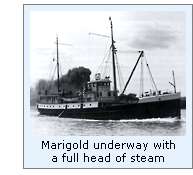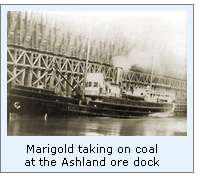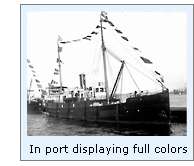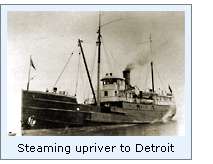|
The
vessel

 In the late 1880's, the tender WARRINGTON was serving both the Engineer
and the Inspector of the Eleventh District, however with a dramatic
increase in the number of aids to navigation in the district, by 1889 a
single vessel was insufficient to keep up with the workload. To this
end, Congress authorized the construction of a new Inspector's tender in
1889. Bids were advertised for construction, with the contract awarded
to the Detroit Dry dock Company in Wyandotte, Michigan.
In the late 1880's, the tender WARRINGTON was serving both the Engineer
and the Inspector of the Eleventh District, however with a dramatic
increase in the number of aids to navigation in the district, by 1889 a
single vessel was insufficient to keep up with the workload. To this
end, Congress authorized the construction of a new Inspector's tender in
1889. Bids were advertised for construction, with the contract awarded
to the Detroit Dry dock Company in Wyandotte, Michigan.
Work
began on the 159-foot 6 inch long iron-hulled vessel, with launching on
November 15, 1890. The vessel was stood 27 feet in the beam and drew 11
feet 7 inches. Displacing 587 tons, her single screw was powered by a
520 horsepower triple expansion steam engine fired by 2 Scotch-type
coal-fired boilers.
 She was delivered to the
Detroit depot in early 1891, and Eleventh District Inspector, Commander
Horace Elmer immediately took her on two trips, the first setting buoys,
and the second supplying and inspecting lighthouse in the district. On
his return, he commented that he "found her suitable for her work,
and satisfactory as to speed and accommodations." By the close of
the 1891 season of navigation, she had steamed 11,058 miles and consumed
602 tons of coal while delivering 18 cords of wood, 402 tons of coal, 18
cords of wood, 10,010 gallons of mineral oil, and removed 123 buoys. She was delivered to the
Detroit depot in early 1891, and Eleventh District Inspector, Commander
Horace Elmer immediately took her on two trips, the first setting buoys,
and the second supplying and inspecting lighthouse in the district. On
his return, he commented that he "found her suitable for her work,
and satisfactory as to speed and accommodations." By the close of
the 1891 season of navigation, she had steamed 11,058 miles and consumed
602 tons of coal while delivering 18 cords of wood, 402 tons of coal, 18
cords of wood, 10,010 gallons of mineral oil, and removed 123 buoys.
I n
April 1894, she was placed in dry dock for an examination of her stern
bearings, her bottom was cleaned and painted and some repairs were made
to her rudder. In March 1897, as a result of a run-in with a rock, she
returned to dry dock for the installation of a new propeller and
electric lights powered by a steam-powered electric generator. n
April 1894, she was placed in dry dock for an examination of her stern
bearings, her bottom was cleaned and painted and some repairs were made
to her rudder. In March 1897, as a result of a run-in with a rock, she
returned to dry dock for the installation of a new propeller and
electric lights powered by a steam-powered electric generator.
With the use of Pintsch
gas illuminated buoys, 1900 saw the installation of a 15,000 cubic foot
capacity gas carrying plant on her main deck, which was not only deemed
as being a satisfactory installation, but an improvement to her weight
distribution and seagoing qualities. In 1905 she steamed her season high
15,929 miles, and consumed 1,137 tons of coal while delivering supplies
to 358 lights, 34 steam powered fog-signals, and charging 37 gas buoys.
 When
the Coast Guard assumed responsibility for the nation's aids to
navigation in 1939, Marigold changed her identity to WAGL-235, and
became the oldest active tender in the nation. After fifty years of
faithful service, she was decommissioned in 1945 and sold into private
ownership the following year. When
the Coast Guard assumed responsibility for the nation's aids to
navigation in 1939, Marigold changed her identity to WAGL-235, and
became the oldest active tender in the nation. After fifty years of
faithful service, she was decommissioned in 1945 and sold into private
ownership the following year.
With her superstructure
removed, and her hull extensively modified, she was rebuilt as a 106
foot long dredge. Renamed MISS MUDHEN II, she operated out of Bay City
Michigan and worked the Saginaw River until the 1980's. Outliving her
usefulness, everything of use was removed from her hull and she was
scuttled in Lake Huron in the 1960's.

Crew members of this vessel

Click here to see a complete
listing of all crew members assigned to the MARIGOLD compiled by
Phyllis L. Tag of Great Lakes Lighthouse Research.

References

Annual reports of the Lighthouse Board, 1891-1903
Dictionary of American Naval Fighting Ships, Vol. 1, Part A
Crew member listings for this vessel
appear courtesy of Great
Lakes Lighthouse Research
|
 In the late 1880's, the tender
In the late 1880's, the tender  She was delivered to the
Detroit depot in early 1891, and Eleventh District Inspector, Commander
Horace Elmer immediately took her on two trips, the first setting buoys,
and the second supplying and inspecting lighthouse in the district. On
his return, he commented that he "found her suitable for her work,
and satisfactory as to speed and accommodations." By the close of
the 1891 season of navigation, she had steamed 11,058 miles and consumed
602 tons of coal while delivering 18 cords of wood, 402 tons of coal, 18
cords of wood, 10,010 gallons of mineral oil, and removed 123 buoys.
She was delivered to the
Detroit depot in early 1891, and Eleventh District Inspector, Commander
Horace Elmer immediately took her on two trips, the first setting buoys,
and the second supplying and inspecting lighthouse in the district. On
his return, he commented that he "found her suitable for her work,
and satisfactory as to speed and accommodations." By the close of
the 1891 season of navigation, she had steamed 11,058 miles and consumed
602 tons of coal while delivering 18 cords of wood, 402 tons of coal, 18
cords of wood, 10,010 gallons of mineral oil, and removed 123 buoys. n
April 1894, she was placed in dry dock for an examination of her stern
bearings, her bottom was cleaned and painted and some repairs were made
to her rudder. In March 1897, as a result of a run-in with a rock, she
returned to dry dock for the installation of a new propeller and
electric lights powered by a steam-powered electric generator.
n
April 1894, she was placed in dry dock for an examination of her stern
bearings, her bottom was cleaned and painted and some repairs were made
to her rudder. In March 1897, as a result of a run-in with a rock, she
returned to dry dock for the installation of a new propeller and
electric lights powered by a steam-powered electric generator. When
the Coast Guard assumed responsibility for the nation's aids to
navigation in 1939, Marigold changed her identity to WAGL-235, and
became the oldest active tender in the nation. After fifty years of
faithful service, she was decommissioned in 1945 and sold into private
ownership the following year.
When
the Coast Guard assumed responsibility for the nation's aids to
navigation in 1939, Marigold changed her identity to WAGL-235, and
became the oldest active tender in the nation. After fifty years of
faithful service, she was decommissioned in 1945 and sold into private
ownership the following year.